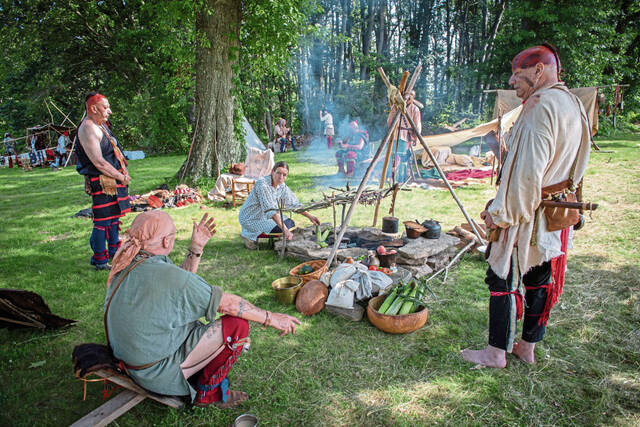https://triblive.com/local/westmoreland/weapons-safety-paramount-at-battle-of-bushy-run-reenactment/
Weapons safety paramount at Battle of Bushy Run reenactment

Bryan Sherwood has been reenacting for 40 years, and he said he’s never felt unsafe surrounded by numerous period replica weapons.
Sherwood, 57, of Ellicott City, Md., participated in the Battle of Bushy Run reenactment as sergeant of the Grenadier company of the 77th Regiment of Foot, also known as Montgomerie’s Highlanders.
“The safety of the weapons has remained remarkably static,” he said. “As far as weapons safety goes, no … it’s never been a continuous problem.”
The safety guidelines come from the Pennsylvania Historical & Museum Commission, and the manual can be found online.
In order to ensure that no accidents happen, there are seven safety officers present at the Battle of Bushy Run reenactment to implement the state safety guidelines, including lead safety officer David Mohr.
At the start of both Saturday’s and Sunday’s reenactments, the team performs safety inspections on the weapons at each of the three encampments at the site — the British, Native Americans and rangers.
Mohr, 89, of Level Green said since he started as a safety officer in 2012 at Bushy Run, he’s never had to fail any weapons for inspection. He also hasn’t witnessed any incidents.
The PHMC Safety Manual for Historic Weapons Programs was most recently updated in January 2018, and according to safety officer Jim Comunale, it doesn’t have to be adapted.
“It’s been the same because it works,” Sherwood said.
Comunale, 69, of Trafford has been a safety officer for over four years at Bushy Run, and he said there’s no reason for safety protocol to be changed.
“It’s the same gun every year, so what safety protocols we take, it works every year,” he said.
Mohr called the manual the safety officers’ bible for checking the weapons and making sure the battlefield is safe.
“The musket’s a relatively simple weapon, but to make sure it’s safe, we have them do four different procedures we check for,” Comunale said.
These include:
• Secure arms: Reenactors must point the barrel of their guns toward the ground to make sure nothing’s inside.
• Search arms: Reenactors must pull the ramrod out of their gun and drop it back into the barrel.
“You should hear a ping — a metal-to-metal ping,” Comunale said.
• Poise fire lock: Safety officers look at the muskets while the reenactors hold them up to make sure there are no cracks in the wood or damage to the barrel.
• Hang fire lock: Reenactors must keep their muskets half-cocked rather than fully cocked, meaning they can squeeze the trigger and it won’t shoot.
“Every time they reenact and they fire the guns at all, we have to redo it all again,” Comunale said. “We watch the battles — generally these guys are all experts.”
During the actual battle, the reenactors shoot the guns at a 45-degree angle, he said.
“It looks like they’re firing at each other — they aren’t,” Comunale said. “They’re actually aiming over their head a little bit. It still looks like a great battle.”
Because they’re shooting blanks, the reenactors said the only way an accident could occur would be if someone intentionally used an actual musket ball when firing instead.
“We don’t allow any live ammunition,” said reenactor John Fraser, 69, of Ligonier. “There’s no risk that someone’s going to load a bullet in one of these muskets.”
Ramrods aren’t used in the field either, Sherwood said, as there were issues with people shooting ramrods toward people during reenactments in the past.
The heat is actually the biggest threat to reenactors, along with officers making people stand in formation for too long, he said, laughing. The last time Sherwood reenacted at Bushy Run was in 2013 for the 250th anniversary of the battle.
Sunstroke, heat stroke, twisted ankles, insect bites and allergic reactions to food are the only issues reenactors come across, Sherwood said.
“Outside of heat and running around making poor decisions … and hurting yourself, this is a relatively safe hobby,” he said.
An expensive hobby
Replica muskets can cost hundreds dollars, reenactors said Saturday.
Actual period weapons aren’t allowed at reenacting events — only replicas.
Sherwood said when he started, he bought his first used musket from a Japanese company for $500.
Nowadays, the used one he bought first would cost more like $1,200, he said.
New replica muskets are going for $1,500 or $1,600, the reenactors said.
The other popular company, which is still widely used, is an Italian company called Pedersoli.
“You can go online and just buy them,” Sherwood said, citing various retail outlets and used musket sites. “The prices for everything (have) gone up astronomically the last few years.”
However, the most expensive replica muskets people can purchase are custom ones. Finished parts can be purchased for up to $1,500, but then people will pay someone to craft and customize them, which can be hundreds to thousands more.
Copyright ©2025— Trib Total Media, LLC (TribLIVE.com)
